Russia all in, still gaining ground; Ukraine in desperate need of united Western support
January is finally here—as in a new year, with new hopes… and new snow—but yet… Ukraine is still battling it out, as the war drags on.
And on.
And on.
Which means maps enclosed below.
But this also brings me to quite an irritating pet peeve (the kind seen on, supposedly eliminated by, but somehow still omnipresent despite efforts to sort out the news by the gods of one lobby or another)--this being that yes, the news these days is incredibly distorted. And while much distortion can be assigned to Russia, much can be assigned to the wannabe whims of... big business.
In the past few weeks I have seen a remarkable number of posts stating that 1) Russian attacks are already fading out, which means that the war is all but over; 2) that the time to get in on the rebuild of Ukraine is now (which also assumes that the war is almost over; that 3) Russian President Vladmir Putin is somehow a legitimate and reasonable negotiating partner (which assumes that the war is almost over) and 4) that despite the fact that US President-elect Donald Trump is the true problem (and yes, he may well turn out to be a massive issue for Ukraine), that the US Joe Biden administration has functioned error-free, but still… the war is all but over, as Russia, NATO and even the Ukrainian people will succumb to the iron will of… Trump.
The last is enough to make anyone’s head spin, such convoluted arguments only seem to attempt to state that US citizenry (and the EU) are simply tired of hearing about the war.
That war fatigue has set in is quite clearly true. But the angle played here is suspect, and it may well be the result of Russian actors and propaganda at work.
Or it may be the US blame game setting in. One side is quite ready to villain-ize Biden for not enacting a no-fly zone; for pushing a doomed counter-offensive; for drip feeding weapons with supposedly big weapons allocations that did not come through on the publicized scale while also limiting the use of long-range weapons Or this may be a combination of both. The second side is quite prepared to blame Trump for claiming Putting is a possible negotiating partner; for his comments denigrating Ukrainian President Volodymyr Zelenskyy; for his promise to cut off weapons supplies (which has no doubt weakened Ukraine’s perceived negotiation power) and for his threats to pull out of NATO.
But the real truth of the matter is that… yes, all of the above can indeed be simultaneously true. Which, with a bit of help through Russian bots, can create the kind of confused mess that seriously inhibits a nation fighting for the life.
Like right now.
For Russian attacks have not faded. And no, there is nothing at this moment to indicate that the end of the war is truly nigh. Yes, Russian manpower is being stretched, with current estimates that troops are now only being replaced at a one-to-one basis, and the quality of new Russian forces hitting the line are quite a bit lower than at the beginning of the war.
That said, despite a suicidal war economy, inflation and the price of eggs, probably shocking losses with regard to foreign troops (yes, the North Koreans), Russia is still all in.
And if you have any doubts, consider the following:
- Russia has taken a hard stance on negotiations to even scale back the war. These include a demand that Ukraine never join NATO, as well as demands that “no threats” may exist to Russia, assumably in any context whatsoever. If the first does not sound like a no-go (and admittedly this may be tempting for Trump and right-wing MAGA types), the second is from and kind of defensive standpoint absolutely illogical (and should be to MAGA types as well). Negotiating with Russia has only ever been remotely successful when approached from a position of strength. This de facto means that there must be a threat level that keeps Russia in place (i.e., which prevents it from invading its neighbors). And for any MAGA believers, take the following quote from the Institute of the Study of War home for study (and muddling over). And yes, for the struggling muddler types, the bold font was added by me:
“Putin demanded in 2021 that NATO commit to not accepting Ukraine or any other countries as new members; the United States commit to upholding the ban on NATO enlargement; NATO not deploy any military forces to states that became NATO members after May 1997; ban any NATO military activity in Ukraine, Eastern Europe, the Caucasus, and Central Asia; ban deployments of intermediate-range missiles in areas that could reach Russian or NATO state territory; and ban the United States from deploying intermediate-range missiles in Europe or nuclear missiles outside of US territory.”
Consider what that means. (And here is the link to the ISW article, which comes complete with it’s own footnotes): https://www.understandingwar.org/backgrounder/russian-offensive-campaign-assessment-january-11-2025
For the muddlers (and spinners), notice that I have not put the NATO-Ukraine membership part of the above in bold. I should have, but did not in order to emphasize the other arguments. For these demands (in bold)—which Putin and Russian Spokesman Dmitry Peskov are somewhat successfully using to spin also as a basis to claim Ukrainian, NATO and US fault for the current war—in summary would constitute NATO and the US not only allowing Russia to take Ukraine and continue to commit genocide at will, but it also would mean abandoning the EU members of Central Europe and the Baltics and effectively castrating NATO itself.
These are no-gos—it would be assumed even for Trump. Such demands—which effectively kill all chance at negotiations are also indicative. While debilitating for the long term—and evil—said demands mean that yes, allow me to repeat the statement: Russia is still all in.
And by all in, this goes beyond the simple fact that Russia is still gaining ground (which I will get to shortly), but also this refers to attempting to erase Ukrainian identity in occupied territories over the long term… by the deportation of children. The Ukrainian ombudsman for human rights has now documented that 3,3100 Ukrainian children have been deported from occupied Kherson alone—with these sent to distant camps in “remote regions of Russia.”
Some may scoff at Ukrainian statistics, but here are a few additional facts:
- A study by Yale University, as reported by Politico, noted that 2,400 from age 6 to 17 were deported to Belarus from occupied Ukraine between September 2022 and May 2023.
- Ukrainian children “received” in Russia—according to Russian Children’s Commissioner Maria Lvova-Belova was claimed to have come to 700,000 by July 2023. The same commissioner said “most” were accompanied by parents or relatives. What “most” in this context means, however, is unknown.
- The Red Cross in Belarus gained media infamy in 2023 when Belarussian Red Cross director Dzmitry Shautsou confirmed on Belarussian TV that Ukrainian children were being “transferred” to Belarus for reasons of “health.” This was at time when former Belarussian Health Minister Pavel Latushko—an official turned activist and now a refugee sentenced to 18 years imprisonment in absentia by the Belarussian government--documented that some 2,100 had in fact been forcibly transferred to the country. And if there is any doubt as to the meaning of forcible transfer of children across boarders… this is called kidnapping.
- And it is on this basis that in March 2023, the International Criminal Court (ICC) in The Hague issued the now infamous warrant for the arrest of both President Vladimir Putin and Lvova-Belova, accusing of the unlawful deportation of children—charges denied by Russia.
But again, there is quite another factor at stake: despite a reduced number of glide bombs due to longer-range Ukrainians strikes--and despite Russia straining to field even somewhat competent troops--Russian forces continue to gain ground. And rebuff preliminary statements by Trump that a deal could soon be in place.
With regard to the latter (and not to defend Trump), way back when the current US president elect first bragged that he could force both sides to a deal in a day, Ukraine’s failed counteroffensive had not yet come to pass. Battlefield realities were far different, and Ukraine was perceived to have the upper hand. Trump repeated the claim later (although he did gradually augment said braggadocio by stating he would end the war quickly, but now it appears that reality has hit home, with the incoming president stating that the war is “a bloody mess” (no news there), but that now he needs “100 days” for the task at hand.
What this means is a worry. Although the Biden administration has attempted to pump money and weapons into Ukraine as a kind of last minute curtain call (with many grumbling behind the scenes that said billions and the easing of restrictions to hit Russian territory should have come far earlier), the assumption remains that Trump will cut support to Ukraine (and here he has also threatened pulling out of NATO, as some members, such as Canada, have not been footing their share of the bill).
While a complete cutoff is unlikely, the flow of monies from the US will slow—and possibly dramatically. And this at a time when the president elect appears to somehow be still campaigning against Democrats and Biden-government spending while also about to take up his position against the background of massive (and still burning) Los Angeles wildfires that may run to some USD 150 bln in damages.
To put that in perspective, the US August package to support Israel during the Israel-Hamas war in August 2023 came to… USD 22 bln.
In short, the Russians keep coming, using meat waves, North Koreans (now depleted by some 4,000 casualties or possibly even deaths), but also by at times both sharp and opportunistic tactics. Which I will quickly note below. But for now the message should remain on point: the war is not over. The West needs to put up a united and resilient front that goes beyond mere EU-ish/NATO-ish mantras of "stand with Ukraine" and which results in organized and well-funded military support, including a no-fly zone over non-occupied areas.
Sure, the suits and ties of the world will scoff at the concept of a no-fly zone. But if the West were to show courage, band together and stand up to Putin and stand against the bombings of civilian targets with true air cover (as in Israel) there would be something in it for business, s the still happening, still premature, still semi-ridiculous investment mixers would at least gain some aura of plausibility.
And now... maps
Kursk...
Say one thing about Ukrainian Chief of Staff Oleksandr Stanislavovych Syrskyi... he is consistent. Last week Ukrainian troops did not only attempt to hold ground in what has become a much narrowed Kursk salient, but actually launched further attacks and reported took ground northwest of Sudzha, wih Ukrainian forces having pushed toward Leonivdovo and Pushkarnove, with (at least at one point) the villages of Cherkasskove Prechnove, Martynovka and Mikhaylovka having fallen to a new Ukrainian drive that (again) caught Russians in the area off guard.
This appears to be an extension of the same strategy begun in the fall of 2023 that was meant to take pressure off of the key logistics hub of Pokrovsk. This strategy remains the subject of much debate, with many analysts (an opposition figures even in Ukraine) believing that it has unfortunately failed and drained key defenses. That said, there is evidence that Kursk--while not necessarily slowing down the Russian offensive at Pokrovsk--did force Russian to pull troops from Kharkiv, Kherson, Kreminna and Bakhmut.
Still, over the last 10 days, Russia has also made its own gains in Kursk, reportedly at Berdin, in counter attacks at Russkoye Porechnoye, Novosonitsky and Leonidovo. Some Russian sources have now claimed that Russkoye Porechnove, Makhnovka and Stara Sorochina have been recaptured.
In short, the situation is fluid. But for perspective, below is a map from Nov. 26, 2024.
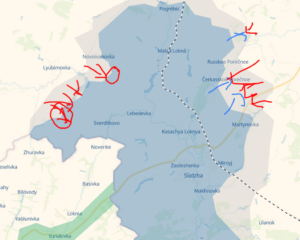
Below is a map of the Kursk salient from Jan. 12, 2025:
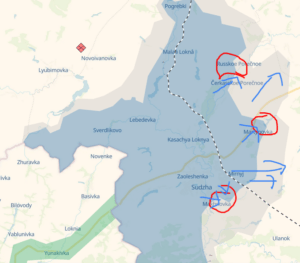
Kupiansk...
There is fighting Those would would like a complete rehash need only venture back a few posts to note that I have long (I believe I began pointing to Kupiansk more than 18 months ago) noted that the Borova-to-Kupiansk section of the the Ukrainian supply line would become key to the north. And for the better part of this time Yours Truly marveled that Ukraine managed to hold off, lose, retake, hold off, lose and retake the tiny village of Sykivka over and over again. Which means Kupiansk would be a hard nut to crack.
And indeed it has not cracked. That said, Russian forces have resorted to a flow-around offensive, which has meant that they have turned to take ground north and south. In the north, this has primarily meant Dvorichna, as well as attempted advances near Kupiansk at Holubivka and Petropavlivka.
And still Ukraine is holding on.
Below is a Map from Nov. 28, 2024:
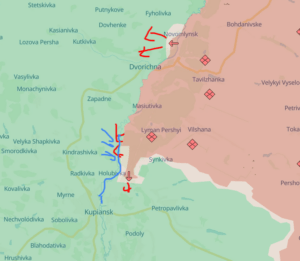
The following is a map from Jan. 11, 2025:
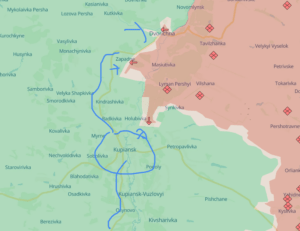
This brings us to the current Kupiansk to Borova line, which can be seen below:
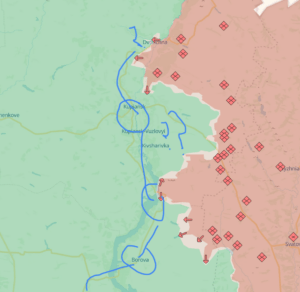
As can be seen above, while not in danger of encirclement at this time, the situation for Ukrainians defending the pocket south of Kupiansk to where the Russians have reached the Oskil (formerly referred to the Pischane drive, but Pischane is long gone) is becoming unfavorable. Likewise, the much anticipated drive to Borova is under way, but the combination of poor weather, only semi-frozen ground and large sections of drone-vulnerable territory have hampered Russian advances.
A wider view reveals that while Ukraine has made Russia pay dearly, Putin's generals have remained dedicated to hitting the long, now vulnerable logistics line that leads from Kupiansk down to Borova, Sloviansk, Kramatorsk, Konstiantynivka and then to Pokrovsk itself.
Below is a map screen shot from Nov. 28, 2024 noting the Kupiansk to Sloviansk line.
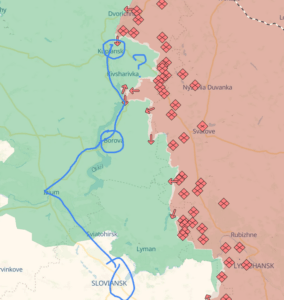
Below is a continuation of that map from the same date noting Borova to Pokrovsk:
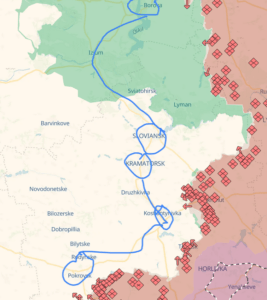
Below is the current situation as of Jan. 12, 2025 showing the Kupiansk to Konstiantynivka line.
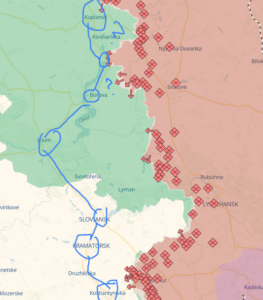
The next map highlights the line to Pokrovka as of Jan. 12, 2025. This map also notes the now sever situation south of Pokrovsk, with the Russians having advanced at Kurakhove:
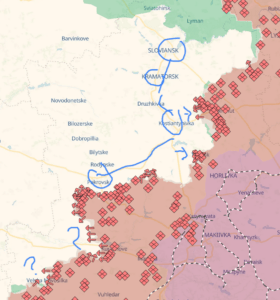
As noted now more than a month ago, the Kurakhove advances--which seemed to be overlooked by some Western observers--have come as a serious setback to Ukraine's defense.
A focus on Kurakhove reveals this in earnest. Below is a map of that section of the line as of Nov. 27, 2024:
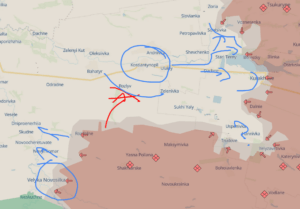
A current snapshot of the same section of the line (Jan. 13, 2025) can be seen below. Note the pressure on Pokrovsk from Shevchenko from the south; the Kurakhove pocket (in danger of encirclement, as these are now small distances, and the desperate fight at Velyka Novosilka where Ukrainian forces are also in danger of encirclement. Noted on the map are Hirnyk and Kurakhove (both having relatively recently fallen) for perspective only. There are no Ukrainian forces at Hirnyk, for example):
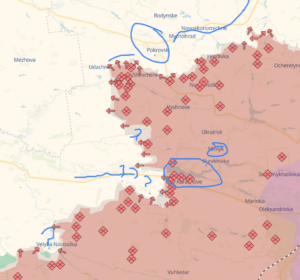
Below is a closer shot of the current Kurakhove to Velyka Novosilka section of the front.
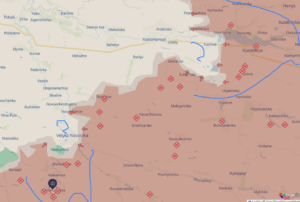
Again, the blue lines in the Russian controlled areas are there only to highlight recently held territory now lost to Russia. As can be surmised, the above developments are hardly positive. Moreover, blogger scans (Russian and Ukrainian) have revealed increased activity still further south in Zaporizhzhia, with one source stating that her city (named of the town withheld) is now buckling down into fortress mode in anticipation of further Russian advances.
Which brings me back to the original premise of this article. No, Russia has not yet burnt out. It is still taking territory, and it seems that this remains the plan.
Trump's plans and rants aside, if the West is going to truly do something, it needs to do it now.
Slava Ukrainii and God bless.
Preston Smith is a licensed investigator based in Gdansk, Poland. He can be reached at query@cddi.pl.
Photo of destruction in Kramatorsk following a January 2025 bombing courtesy of Dsns.gov.ua, CC BY 4.0 <https://creativecommons.org/licenses/by/4.0>, via Wikimedia Commons.
All maps courtesy of DeepstateUA.


